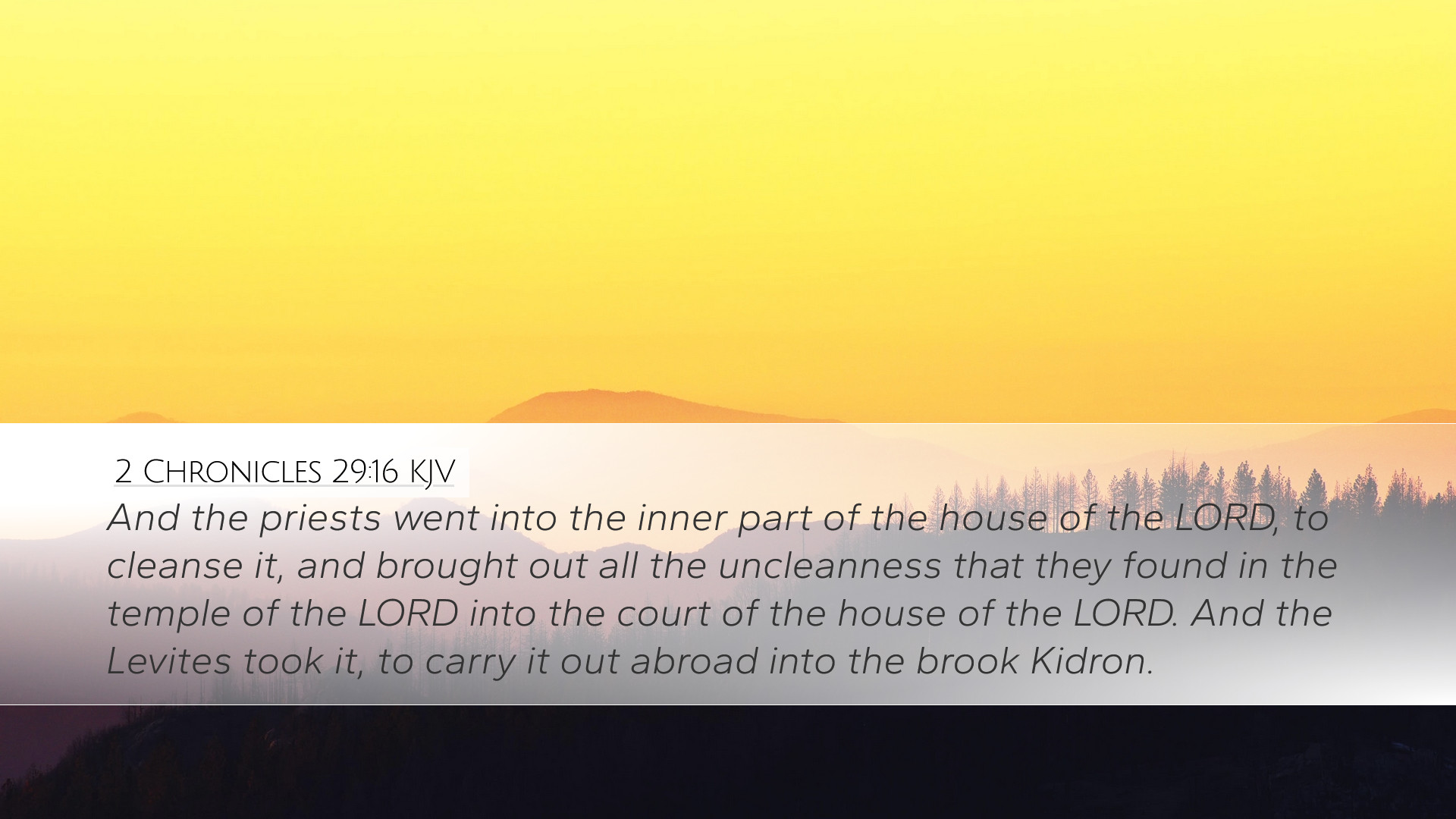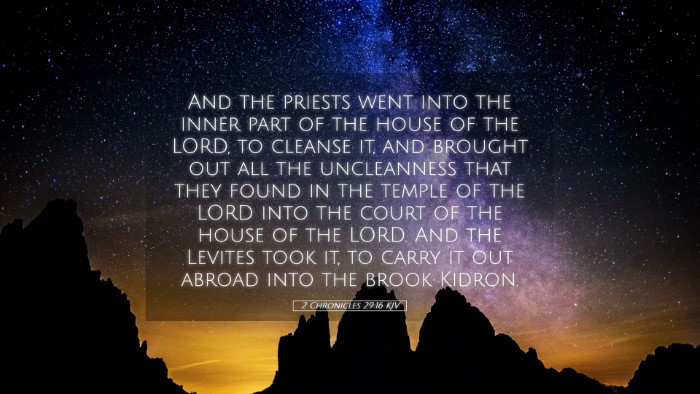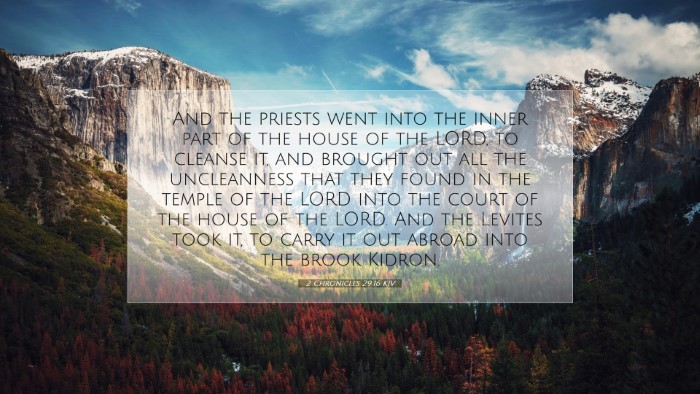Commentary on 2 Chronicles 29:16
2 Chronicles 29:16 states: "And the priests went into the inner part of the house of the LORD to cleanse it, and brought out all the uncleanness that they found in the temple of the LORD into the court of the house of the LORD." This verse marks a significant moment in the religious reformation led by King Hezekiah. The act of cleansing the temple signifies a return to proper worship and a healing of the nation’s relationship with God. In this commentary, we will explore the deeper meanings, implications, and lessons from this verse.
Historical Context
The context of this verse is set during the reign of King Hezekiah, who sought to restore the worship of Yahweh in Judah after years of neglect and idolatry. Matthew Henry emphasizes the importance of this moment in history, noting that Hezekiah's desire to reform the temple worship was both a political and spiritual necessity.
Insights from Public Domain Commentaries
Matthew Henry’s Perspective
Matthew Henry comments on the significance of the priests' actions, highlighting their role as mediators between God and the people. He notes that the priests' effort to cleanse the temple was not merely a physical act but a symbolic purification. Henry writes:
“As the house of the Lord was the place of His peculiar residence, so it should be the very best place upon earth; everything in it should be pure and holy.”
He stresses that the cleansing was necessary because it demonstrated a return to holiness and reverence required in God’s presence.
Albert Barnes’ Interpretation
Albert Barnes provides a detailed analysis of the term "cleanse." He relates this act of cleansing to the broader biblical principle of purification, noting:
“The ceremonial cleanliness of the priests and the sanctuary was essential for acceptable worship. By removing the ‘uncleanness,’ they made way for the return of God’s presence.”
Barnes emphasizes that physical cleanliness of the temple parallels spiritual cleanliness among the people. He connects the act of cleansing with revival and national repentance from sin.
Adam Clarke’s Commentary
Adam Clarke, known for his thorough exegesis, explores the implications of the priests going “into the inner part of the house of the LORD.” He notes:
“This is a sign of their commitment to God’s service, showing that when true reform is needed, leaders must lead by example and involve themselves in the work that brings glory to God.”
Clarke highlights that this moment involves not only cleansing but also leadership in spiritual matters. The priests are seen as crucial facilitators in restoring the worship practices that God commanded.
Theological Significance
The temple represents more than just a physical structure; it symbolizes the relationship between God and His people. The act of cleansing signifies a deep desire for restoration and holiness. Hezekiah’s initiative, supported by the priests, illustrates a critical truth: spiritual renewal begins with a recognition of need and a commitment to action.
Symbolism of Cleansing
- Cleansing as a Metaphor: The physical act of cleansing mirrors the spiritual cleansing that believers need in their lives. This is also echoed in New Testament themes, particularly in the teachings of Jesus about purity and repentance.
- Leadership in Restoration: The involvement of the priests shows that spiritual leaders must take an active role in guiding their congregations toward true worship. Their actions were a public declaration of their commitment to Yahweh.
Implications for Worship
This verse challenges contemporary audiences—pastors, theologians, and believers—to reflect on their own worship practices. Are we maintaining the sanctity of our places of worship? Are we engaging in true repentance and making room for God's presence in our congregations?
Lessons for Today’s Church
The imperative to cleanse extends beyond physical spaces into the hearts and lives of believers. As noted by the commentators, a few lessons emerge from this scripture:
- Commitment to Purity: The necessity for purity in worship is timeless. Just as the temple was cleansed, so too must the lives of believers be purified from sin and idolatry.
- The Role of Leadership: Leaders are called to exemplify integrity and zeal for God's house. Leaders must actively work to foster a culture of reverence and holiness within their churches.
- Community Involvement: Just as the priests involved the community in the restoration, the church today must cultivate a communal approach to worship that invites active participation from all members.
Conclusion
2 Chronicles 29:16 serves as a powerful reminder of the importance of cleansing and restoring our worship spaces, both physical and spiritual. Through a comprehensive understanding derived from Matthew Henry, Albert Barnes, and Adam Clarke, we are called to examine our practices, leadership, and community involvement in the pursuit of authentic worship. As we seek to 'cleanse' ourselves and our places of worship, we foster an environment where God can dwell among us, transforming our hearts and communities for His glory.


